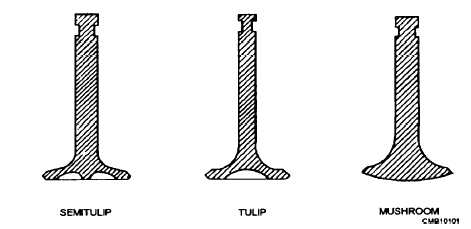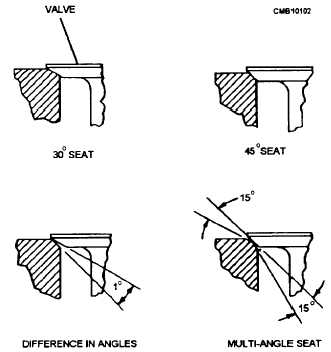
Figure 3-50. - Valve shapes.
mates with a crowned tappet face. The camshaft lobe does not meet the tappet in the center of its face. The design causes the tappet face to rotate on the cam lobe, rather than slide. This greatly increases component life.
Valve and Valve Seats
Each cylinder in a four-stroke-cycle engine must have one intake and one exhaust valve. The valves that are commonly used are of the poppet design. The word poppet is derived from the popping action of the valve. Poppet-type valves are made in the following three basic shapes: semitulip, tulip, and mushroom (fig. 3-50). The valve shape used in a given engine depends on requirements and shape of the combustion chamber.
Construction and design considerations are very different for intake and exhaust valves. The difference is based on their temperature operating ranges. Intake valves are kept cool by the incoming intake mixture. Exhaust valves are subject to intense heat from the burnt gases that pass by it. The temperature of an exhaust valve can be in excess of 1300F. Intake valves are made of nickel chromium alloy. Whereas, exhaust valves are made from silichrome alloy. In certain heavy-duty and most air-cooled engines, the exhaust valves are sodium filled. During engine operation, the sodium inside the hollow valve melts. When the valve opens, the sodium splashes down into the valve head and collects heat. Then, when the valve closes, the sodium splashes up into the valve stem. Heat transfers out of the sodium, into the stem, valve guide, andengine coolant. In this way, the valve is cooled. Sodium-filled valves are light and allow high engine rpm for prolonged periods.
In vehicles that use unleaded fuel, a stellite valve is preferred. A stellite valve has a special hard metal coating on its face. Lead additives in gasoline, other than increasing octane, act as a lubricant. The lead coats the valve face and seat to reduce wear. With unleaded fuel, the wear of the valve seat and valve face is accelerated. To prevent this and prolong valve service life, use a stellite valve.
Valve seats are important, as they must match the face of the valve head to form a perfect seal. The seats are made so they are concentric with the valve guides; that is, the surface of the seat is an equal distance from the center of the guide all around Although some earlier engines were designed with flat contact surface for the valve and valve seat, most are now designed with valve seat angles of 30 to 45 degrees, as shown in figure 3-51. This angle helps prevent excessive accumulation

Figure 3-51. - Valve-to-valve seat relationship.
Continue Reading